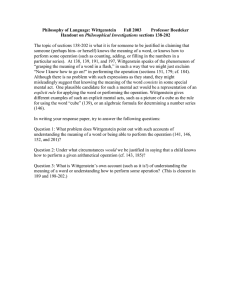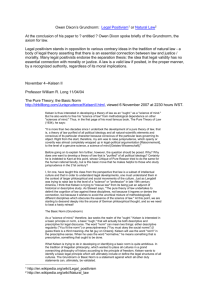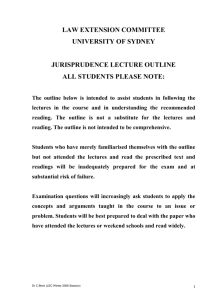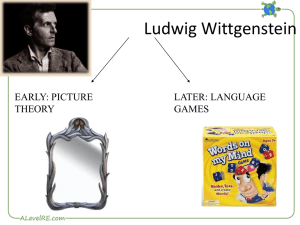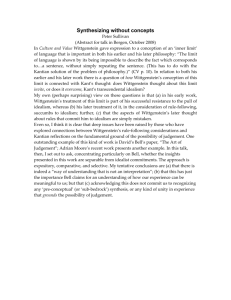Meaning, Logic, and the Systematization of Law:
advertisement
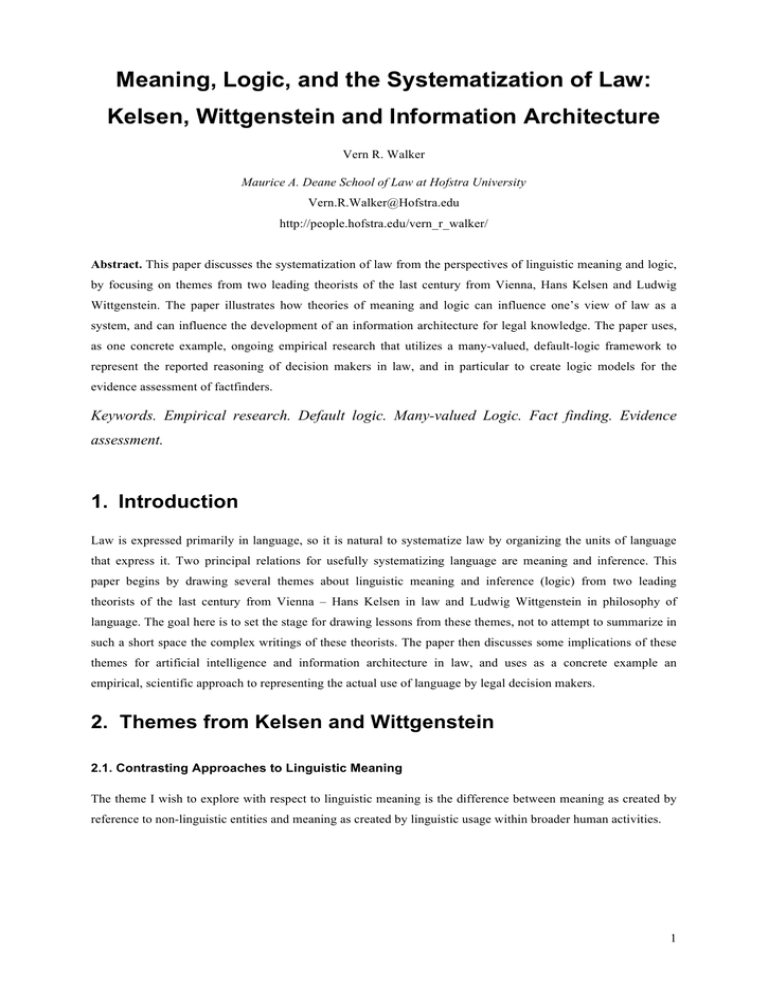
Meaning, Logic, and the Systematization of Law: Kelsen, Wittgenstein and Information Architecture Vern R. Walker Maurice A. Deane School of Law at Hofstra University Vern.R.Walker@Hofstra.edu http://people.hofstra.edu/vern_r_walker/ Abstract. This paper discusses the systematization of law from the perspectives of linguistic meaning and logic, by focusing on themes from two leading theorists of the last century from Vienna, Hans Kelsen and Ludwig Wittgenstein. The paper illustrates how theories of meaning and logic can influence one’s view of law as a system, and can influence the development of an information architecture for legal knowledge. The paper uses, as one concrete example, ongoing empirical research that utilizes a many-valued, default-logic framework to represent the reported reasoning of decision makers in law, and in particular to create logic models for the evidence assessment of factfinders. Keywords. Empirical research. Default logic. Many-valued Logic. Fact finding. Evidence assessment. 1. Introduction Law is expressed primarily in language, so it is natural to systematize law by organizing the units of language that express it. Two principal relations for usefully systematizing language are meaning and inference. This paper begins by drawing several themes about linguistic meaning and inference (logic) from two leading theorists of the last century from Vienna – Hans Kelsen in law and Ludwig Wittgenstein in philosophy of language. The goal here is to set the stage for drawing lessons from these themes, not to attempt to summarize in such a short space the complex writings of these theorists. The paper then discusses some implications of these themes for artificial intelligence and information architecture in law, and uses as a concrete example an empirical, scientific approach to representing the actual use of language by legal decision makers. 2. Themes from Kelsen and Wittgenstein 2.1. Contrasting Approaches to Linguistic Meaning The theme I wish to explore with respect to linguistic meaning is the difference between meaning as created by reference to non-linguistic entities and meaning as created by linguistic usage within broader human activities. 1 2.1.1 Kelsen’s Approach to Linguistic Meaning in his Classical Period In his classical period (that is, the period through the publication of the second edition of his Pure Theory of Law in 1960), Kelsen regarded legal norms as the meanings of certain law propositions, thus creating a correspondence between existing legal norms and valid commands by legal authorities. First, Kelsen’s inquiries into the justification for coercive governmental action led to a view of law as a system of binding norms. For Kelsen, the law consists of valid legal “norms” (or a valid “system of norms” or a “normative order”) (Kelsen 1967, p. 75). A legal norm (“Rechtsnorm”; id., p. 72) is a command, permission or authorization (id., p. 71). Legal norms or commands can be “general norms” (e.g., a statute) or “individual norms” (e.g., a court decision) (id., pp. 206-07; Kelsen 1945, pp. 37-38). When “legal norms are linguistically expressed in words and sentences, they may appear in the form of assertions stating facts” (e.g., “Theft is punished by imprisonment”), but the linguistic form should not mislead us about their true nature as commands (Kelsen 1967, pp. 7, 71-72). To say that a legal norm is “‘valid’ means that it is binding – that an individual ought to behave in the manner determined by the norm” (id., p. 193; Kelsen 1945, pp. 30-32). A legal norm “cannot be true or false, because it is not an assertion about a fact – not a description of an object but a prescription – and is as such the object to be described by the science of law” (Kelsen 1967, p. 73). By contrast, sentences within the “science of law” describe the legal norms. That is, the science of law describes the legal norms created by acts of human behavior and to be applied and obeyed by such acts; and thereby describes the norm-constituted relations between the facts determined by the norms. The sentences by which the science of law describes these norms and relationships must be distinguished as ‘rules of law’ from the legal norms that are created by the legal authorities, applied by them, and obeyed by the legal subjects. (Id., pp. 71, 102; Inama 2010-2011, pp. 48-51, 57-60.) A “law proposition” or “rule of law” (“Rechtssatz”; Kelsen 1967, p. 72) is conditional in form: “The statement describing the validity of a norm of criminal law that prescribes imprisonment for theft … can be formulated only in this way: If somebody steals, he ought to be punished” (id., p. 74-75). Moreover, the conclusion of the conditional must be an ought-statement because it describes a legal norm that prescribes that something ought to occur (id., p. 74). A criminal code might contain the sentence: Theft is punished by imprisonment. The meaning of this sentence is not, as the wording seems to indicate, a statement about an actual event; instead, the meaning is a norm: it is a command or an authorization, to punish theft by imprisonment. (Id., p. 7.) To say that a law command is “valid” is to say that the norm that is its meaning “exists,” and that the command has objective “binding force” (Kelsen 1945, pp. 30, 395; 1967, pp. 3, 5). For the purpose of exemplifying this theme of correspondence as meaning, I need not discuss the controversy surrounding Kelsen’s theory of meaning (see, e.g., Green 2003, pp. 381-409), nor explore in Kelsen’s later period the ambiguities of deontic sentences and non-deontic propositions about validity (see Paulson 1992, pp. 271, 273). 2.1.2 Wittgenstein’s Later Approach to Linguistic Meaning In his Tractatus Logico-Philosophicus, Wittgenstein postulated that the meaning of logico-linguistic entities (words, propositions) derives from a fundamental correspondence with objects and states-of-affairs in the world (see Wittgenstein 1963 §§ 1, 1.1; 2, 2.1, 2.2; 3, 3.1, 3.2, 3.203, 3.3; 4, 4.001, 4.002, 4.1), and his Philosophical Investigations begins with by characterizing this “particular picture of the essence of human language”: 2 [T]he individual words in language name objects – sentences are combinations of such names. –– In this picture of language we find the roots of the following idea: Every word has a meaning. This meaning is correlated with the word. It is the object for which the word stands. (Wittgenstein 1958, § 1.) But Wittgenstein had later developed a new conception of how language works, which discarded the correspondence theory of meaning and emphasized that the meaning of language is its use as part of other human activities. “[T]o imagine a language means to imagine a form of life [“Lebensform”]” (id., § 19). He called “the whole, consisting of language and the actions into which it is woven, [a] ‘language-game’ [“Sprachspiel”]” (id., § 7). His use of “the term ‘language-game’ is meant to bring into prominence the fact that the speaking of language is part of an activity, or of a form of life” (id., § 23, emphasis in original). Wittgenstein emphasized that there are “countless different kinds of use of what we call ‘symbols,’ ‘words,’ ‘sentences,’” involved in such activities as “giving orders, and obeying them,” “reporting an event,” “making up a story,” or “solving a problem in practical arithmetic” (id., § 23). Wittgenstein thought that we have a tendency to slip (like the author of the Tractatus did) into simplistic and misleading pictures, if we do not keep in mind the multiplicity of language-games (id., § 24). 2.2 Contrasting Approaches to Logic The theme I wish to explore with respect to logic is the difference between logic as a formal system of correct reasoning separate from natural language and logic as a certain kind of language-game involving inference. 2.2.1 Kelsen’s View of Logic in his Classical Period In his classical period, Kelsen viewed logic as deductive, syllogistic reasoning. (For my purposes, I need not discuss Kelsen’s later, dramatically different views of the relevance of logic to law (see Paulson 1992, p. 273).) Kelsen viewed logic as playing a structural role in organizing and evaluating both the science of law and law itself: Logical principles are applicable, indirectly, to legal norms to the extent that they are applicable to the rules of law which describe the legal norms and which can be true or false. Two legal norms are contradictory and can therefore not both be valid at the same time, if the two rules of law that describe them are contradictory; and one legal norm may be deduced from another if the rules of law that describe them can form a logical syllogism. (Kelsen 1967, p. 74.) The laws of logic can be applied in the science of law, therefore, to study particular legal systems. [L]ogical principles in general, and the Principle of the Exclusion of Contradictions in particular, are applicable to rules of law describing legal norms and therefore indirectly also to legal norms. Hence it is by no means absurd to say that two legal norms “contradict” each other. And therefore only one of the two can be regarded as objectively valid. To say that a ought to be and at the same time ought not to be is just as meaningless as to say that a is and at the same time that it is not. A conflict of norms is just as meaningless as a logical contradiction. (Id., p. 206.) If two legislative acts within the same legal system are contradictory, “we then have a meaningless act of norm creation” and “no objectively valid legal norm is present” (id., p. 207; Green 2003, pp. 406-407). Thus, even a procedurally correct act of norm-creation is subject to the laws of logic and the theory of meaning. Deductive, syllogistic reasoning in the science of law also performs the critical task of determining the validity of legal norms, drawing upon a “higher norm” to help deduce a “lower norm” (see id., p. 193). The foundation of the validity of a positive norm, that is, one established by an act of will and prescribing a certain behavior, is the result of a syllogistic procedure. In this syllogism, the 3 major premise is the assertion about a norm regarded as objectively valid, according to which one ought to obey the commands of a certain person, that is, one ought to behave according to the subjective meaning of these commands; the minor premise is the assertion of the fact that this person has commanded to behave in a certain way; and the conclusion is the assertion of the validity of the norm: that one ought to behave in this particular way. Thus the norm whose validity is stated in the major premise legitimizes the subjective meaning of the command, whose existence is asserted in the minor premise, as the command’s objective meaning. (Id., p. 202.) So the science of law applies syllogistic reasoning to its descriptive statements (and derivatively to the prescriptive norms those statements describe) in order to establish the validity (objective binding force) of positive legal commands. (Note, however, that deduction only establishes the procedural validity of a law command, not the substantive content of the command (see Green 2003, pp. 375-381; Northrop 1962, pp. 10291032; Paulson 2005, p. 530).) 3.2.2 Wittgenstein’s Later View of Logic When Wittgenstein wrote the Tractatus, the symbolic logic developed by Alfred North Whitehead and Bertrand Russell in Principia Mathematica provided the pure logical form for analyzing descriptive natural language (see, e.g., Wittgenstein 1963, § 4.002; Anscombe 1963, p. 92; Baker and Hacker 2005, pp. 271-273). Wittgenstein’s later thinking about linguistic meaning, however, also led to a change in his notion of logic: We see that what we call “sentence” and “language” has not the formal unity that I imagined, but is the family of structures more or less related to one another.—But what becomes of logic now? Its rigour seems to be giving way here.—But in that case doesn’t logic altogether disappear? (Wittgenstein 1958, § 108.) With the shift to forms of life and language-games as “the given” (Kerr, pp. 69-76), inference is not an activity separate from word use. Playing a language-game in an acceptable way involves conforming to the rules of play, which also involves spotting “a mistake in applying” words (Wittgenstein 1969, §§ 28-29, 80-83). Using words appropriately includes what we call “making inferences,” and it is still true, as stated in the Tractatus, that “[t]o understand a proposition means to know what is the case if it is true” (Wittgenstein 1963, § 4.024). Logic’s task is to capture the rules of play, and provide a “description of the language-game” (Wittgenstein 1969, § 82). This task is similar to that of grammar: to show the appropriate use of linguistic expressions in various language-games (Wittgenstein 1958, §§ 370-373; Wittgenstein 1969, §§ 51, 56, 82, 96-99). 2.3 Contrasting Approaches to Systematization One’s approach to meaning and to logic influences one’s view of law as a system, and the theme I wish to explore is the difference between law as a single, coherent system and law as clusters of related activities. 2.3.1 Kelsen’s Systemic Architecture from his Classical Period If deductive syllogisms provide the proof that a positive legal command is valid, then this pursuit of “objective meaning” or validity must stop at some point. As Kelsen states: But the search for the reason of a norm’s validity cannot go on indefinitely like the search for the cause of an effect. It must end with a norm which, as the last and highest, is presupposed. It must be presupposed, because it cannot be “posited,” that is to say: created, by an authority whose competence would have to rest on a still higher norm. … Such a presupposed highest norm is referred to in this book as basic norm. 4 (Kelsen 1967, p. 194-95.) This “basic norm” (“Grundnorm”; id., p. 8) is the postulate for syllogistic reasoning about objectively binding legal norms. One function of the Grundnorm is to create objective validity (objective binding force) for otherwise purely subjective commands (orders of an individual person or legal institution). If we define “the constitution of a legal community” as being “the norm or norms that determine how (that is, by what organs and by what procedure – through legislation or custom) the general norms of the legal order that constitute the community are to be created,” then the basic norm is presupposed when the constitutioncreating process is “objectively interpreted as a norm-creating fact” (id., p. 198-99; Kelsen 1945, pp. 395-396). In a dynamic norm system, such as a positive legal order, the basic norm supplies only the reason for the validity of a general or individual norm, but not the content of such a derived norm (Kelsen 1967, pp. 196-197; 1945, p. 113; Green 2003, pp. 375-381; Paulson 2005, p. 530). The governmental institution that issues a valid positive norm supplies its content. But “the multitude of general and individual legal norms, created by the legal organs, becomes a unitary system, a legal ‘order,’ through the science of law” (Kelsen 1967, p. 72), and “[i]t is the basic norm that constitutes the unity in the multitude of norms by representing the reason for the validity of all norms that belong to this order” (id., p. 195). 3.3.2 Wittgenstein’s Later Reaction to Systematization Systematization plays no productive role in Wittgenstein’s later thought. He combated the human tendency to formulate simplifying pictures, which then ensnare us within metaphysical traps. There are a vast number of language-games (Wittgenstein 1958, § 24), and we realize this if we pay close attention to how words are actually used: “don’t think, but look!” (id., §§ 66, 340). In a very local sense of “system,” a single languagegame might contain small systems of propositions (Wittgenstein 1969, §§ 141-142), whose rules of use logic can explore. Or one might investigate a family of language-games collectively called “systematization,” which would include such language-games as devising axiom systems or arranging objects by genus-and-species. But Wittgenstein actively resisted positing a “system” in any larger sense, such as a meta-game for language-games. 3 Implications for an Empirical Science of Legal Language This part of the paper argues that such differences of approach with respect to meaning, logic and systematization have practical implications for applying artificial intelligence to law and for devising an information architecture for law. I can only suggest a few implications here, and I will illustrate them using the concrete example of the logic modeling currently underway at Hofstra Law School’s Research Laboratory for Law, Logic and Technology (the LLT Lab). The Lab investigates the fact-finding reasoning in reported legal decisions, such as claims for compensation due to injuries caused by vaccinations, under the Vaccine Injury Compensation Program (VICP) in the United States. The LLT Lab utilizes the Default-Logic Paradigm as the formal methodology for its modeling (Walker, 2007a; 2007b; 2009; Walker et al. 2011), which provides a logic framework for representing the reasoning of factfinders. Drawing upon ideas from both Kelsen and Wittgenstein, the Lab pursues the study of law as an empirical undertaking, founded on careful application of scientific method to the language of actual legal decision makers. 3.1 Capturing the Meaning of Legal Language A close empirical look at actual judicial decisions reveals a variety of sentences – sentences that issue or describe legal rules; sentences that describe evidence, or evaluate the plausibility of evidence, or state inferences from 5 evidence, or make findings of fact; and sentences that express policy-based reasoning. This section briefly discusses sentences describing rules and sentences assessing evidence. The approach to linguistic meaning is that of Wittgenstein’s later period. 3.1.1 Capturing the Meaning of Legal Terminology within Legal Rules Representing the reasoning in a reported legal decision begins with capturing the valid legal rules that are potentially applicable to the case. A system of rules can be modeled as an inverted “rule tree.” Figure 1 shows part of the rule tree for a vaccine decision. The top node of the tree is the ultimate issue to be proved by the petitioner seeking compensation – namely, the proposition that “the petitioner is entitled to compensation under the National Vaccine Injury Compensation Program.” Each level of each branch extending downward from the top node states the logical conditions for proving the immediately higher proposition. For example (in the lower center of Figure 1), the condition that “the vaccine was ‘not only a but-for cause’ of the injury and/or the death, ‘but also a substantial factor in bringing about’ the injury and/or the death” is proved by proving all of three subissues: (1) that a “medical theory causally connects” the vaccination and the injury and/or the death; (2) that a “logical sequence of cause and effect” shows that the vaccination “was the reason for” the injury and/or the death; and (3) that a “proximate temporal relationship” exists between the vaccination and the injury and/or the death. The authoritative source of this 3-pronged rule is the decision Althen v. Secretary of Health and Human Services, 418 F.3d 1274, 1278 (Fed. Cir. 2005). Inferences proceed upward, with lower levels of the rule tree providing conditions for proving higher levels. Every proposition in a rule tree has one of three values: “true” / “undecided” / “false”. When a legal proceeding begins, all propositions in the rule tree are “undecided.” The role of the factfinder is to assess the evidence, and to determine which rule conditions are true and which are false. Figure 1. Part of the Vaccine Act rule tree, containing the three Althen sub-issues for causation-in-fact, and illustrating the logical connectives AND, OR and UNLESS. 6 Figure 1 also illustrates the use of three logical connectives for inferring a rule’s conclusion (on an upper level) from its condition(s) (on the immediately lower level): • • • “AND” (the conclusion is true if but only if all supporting conditions are true); “OR” (the conclusion is true if but only if at least one of the supporting conditions is true); and “UNLESS” (if the defeating condition is true, then the conclusion is false, even if the supporting prima facie conditions are true). When the factfinder makes findings of fact about the rule conditions at the ends of the branches of the rule tree, the tree’s logical connectives propagate those values upward, determining the truth-values of propositions throughout the tree, including the truth-value of the ultimate issue at the top. The rule trees of the Lab’s models capture the rules of word usage that have been established by legal authorities as binding on participants in the language-games of legal decision making. The appropriate use of a distinctively legal word is shown in the propositions the word helps to prove true (higher in the rule tree), as well as in the propositions that prove it to be true (lower in the branch of the rule tree). In law, the use and meaning of a word can be quite different from the meaning of the same word in other legal contexts or in non-legal contexts. For example, the word “causes” has a meaning in vaccine compensation cases that is somewhat different than the meaning of the same word in tort law, and probably very different than in particular criminal statutes, and certainly very different than in scientific contexts or in everyday commonsense contexts. 3.1.2 Capturing the Meaning of Evidence Assessment (Fact finding) Given the rule tree, the second task is to represent the evidentiary reasoning of the factfinder. The factfinder must decide which evidence is relevant to proving which issues of fact (rule conditions), evaluate the plausibility of the evidence that is relevant, organize the evidence and make reasonable inferences based on it, and make findings of fact about the contested rule conditions. Models of that reasoning, attached to the relevant rule conditions in the rule tree, consist of “evidentiary assertions” (as nodes) and “plausibility connectives” (as logical connectives). Evidentiary assertions represent either the evidence (e.g., statements made by testifying witnesses or statements contained in documentary exhibits) or the statements of the factfinder (e.g., announcing a finding of fact, or describing an evidentiary exhibit or a witness’s demeanor). Evidentiary assertions are assigned plausibility-values using an ordinal, seven-valued scale, with the values being: “highly plausible” / “very plausible” / “slightly plausible” / “undecided” / “slightly implausible” / “very implausible” / “highly implausible”. Evidentiary assertions possess content as well as metadata. As illustrated by the last item in Figure 2, an evidentiary assertion’s content might be “The varicella vaccine can cause ‘an immune-mediated inflammatory response,’ which could ‘negatively affect the nervous system,’” and its metadata could include the page citation to the decision, the source making the assertion, and the basis for the assertion (represented in square brackets after the content, and captioned as “C:” “S:” and “B:” respectively). 7 Figure 2. Part of the evidence assessment in the Casey decision, as modeled in the Legal Apprentice software, and illustrating the plausibility connective MAX. “Plausibility connectives” organize evidentiary assertions into logical structures. Plausibility connectives are similar to logical connectives, but operate on seven plausibility-values instead of three truthvalues. The plausibility counterparts to the three logical connectives listed above are: • • • “MIN” (the counterpart to AND, assigning to the conclusion the lowest plausibility-value possessed by any of its conditions or supporting assertions); “MAX” (the counterpart to OR, assigning to the conclusion the highest plausibility-value possessed by any of its conditions or supporting assertions); and “REBUT” (the counterpart to UNLESS); if the rebutting assertion is plausible to any degree, then the conclusion is assigned a degree of implausibility inverse to the degree of plausibility of the rebutting assertion – for example, if the rebutting defeater is “highly plausible,” then the conclusion is “highly implausible,” but if the defeater is only “slightly plausible,” then the conclusion is only “slightly implausible”; if the rebutting assertion is not plausible, then it has no effect on the conclusion’s plausibility. Finally, a logic model contains plausibility-values for its terminal assertions, so that the plausibility- values and truth-values throughout the model represent the evaluations of the factfinder. Figure 2 is a screen shot of part of the Legal Apprentice model for the vaccine decision Casey v. Secretary of Health and Human Services, Case No. 97-612V (December 12, 2005). (Legal Apprentice is the software platform that the Lab uses to create its logic models.) On a color computer display or a page printed in color, the round icon before each assertion has a color that indicates the plausibility-value of the assertion on that line (shades of green for plausibility, white for undecided, and shades of red for implausibility). Figure 2 illustrates a finding of the special master (the factfinder) that “there is an adequate medical theory of causation,” supported by two alternative lines of reasoning (connected by the plausibility connective MAX) that are based on two causal pathways (direct viral infection and immune-mediated inflammatory response). The entire “inference tree” of the model, which includes the rule tree and the attached evidence assessment, therefore represents the reasoning of the factfinder in the particular legal decision. The evidence assessment extensions of the rule trees capture important linguistic patterns of individual factfinders as they conduct fact finding and try to follow the binding rules of legal language-games in new situations. Factfinders must participate in the non-legal language-games of the testifying witnesses, when they understand the testimony, evaluate its plausibility, and make commonsense inferences from it. And factfinders must link the many language-games and meanings together in their findings of fact, which combine in a 8 meaningful way the evidentiary words of the witness and the legal words of the legal rules – for example, in finding that the defendant’s conduct “caused” the plaintiff’s injury. 3.2 Capturing the Logic of Legal Reasoning The logic modeling of the Lab respects Wittgenstein’s later expansion of the use of the word “logic” to include aspects of grammar and rule-stating word usage, but it also accepts, as Kelsen did, that formal systems of logic can play an important role. However, the Lab’s pragmatic approach regards particular formal logics merely as potentially useful tools for particular purposes. For example, in order for artificial intelligence to automate portions of legal reasoning, various logical tools (systems) might play a role as blueprints for programming. Many-valued default logics are proving useful, and modal logics, temporal logics and deontic logics may well be also. But formal systems must be adapted to, calibrated against, and tested on the Lab’s database of logic models for natural-language legal decisions. Bottom-up rigorous empirical studies of actual linguistic usage by legal decision makers should complement and test top-down studies of logic systems and software designs. The Lab’s models of judicial decisions capture the reasoning provided as support for a judicial judgment, but there are numerous types of governmental activities that require justification. For example, at least in common law jurisdictions, judicial decisions occasionally adopt new legal rules that are supported by policybased reasoning (Walker 2007a, pp. 205-207). Moreover, there are many types of non-judicial, governmental action (e.g., enacting statutes, issuing administrative rules, issuing technical reports, maintaining educational websites), each with its type of justifying reasoning. For example, justifications for adopting rules may depend upon findings of fact that a particular rule is likely to produce particular kinds of consequences. In modeling such supporting reasoning, the important work in artificial intelligence and law over the last 25 years on case-based reasoning and analogical reasoning comes into play, as well as work on meta-rule sentences about validity (Yoshino 1995; 2011). It may also be useful to develop many-valued, deontic logics in order to automate important sub-tasks within policy-based reasoning. 3.3 Capturing Systems of Word Use in Legal Language-Games The LLT Lab’s empirical approach to representing judicial decisions results in a picture of “the law” that is more disjointed than Kelsen envisioned, but probably far more systematic than Wittgenstein would have preferred. Modeling the judicial decisions in a substantive legal area represents “the law” through the following elements: • A set of rule trees that capture the proper use of the legal terminology in that legal area at any given point in time (incorporating, for example, the original statute, later amendments to the statute, any applicable administrative rules, and any case-law interpretations of the statute and regulations); • A collection of logic models for the legal decisions applying those legal rules, which documents recurring patterns of word use in fact finding about various types of evidence; and • A library of patterns of reasoning (word use) extracted from the evidence assessments of the logic models in the sample. Yet this complex information architecture represents only the reported reasoning in judicial decisions in only one substantive legal area. By imagining such a structure multiplied by the large number of substantive areas of law in a modern state, and supplemented with reasoning models for the many kinds of action performed by other governmental institutions, we can begin to picture “the law” as a system. But the system may resemble a vast galaxy of stars more than it does an axiomatic system. 9 4 Conclusion Empirically studying the actual language that legal decision makers use to justify their actions requires decisions about the theory of meaning to employ and the role of logic, which influence in turn the view of law as a system. The many-valued, default-logic models of the LLT Lab provide one concrete example of the possibilities. References 1. Anscombe GEM (1963) An introduction to Wittgenstein’s Tractatus. 2nd ed., Harper & Row, New York 2. Baker GP, Hacker PMS (2005) Wittgenstein: understanding and meaning, Volume 1 of An analytical commentary on the Philosophical Investigations, Part I: Essays. Blackwell Publishing, Malden, Massachusetts 3. Green MS (2003) Hans Kelsen and the logic of legal systems. Alabama Law Review 54, 365-413 4. Inama CR (2010-2011) Hans Kelsen’s legal positivism and international law. Lincoln Law Review 38, 41-85 5. Kelsen H (1945) General theory of law and state. Anders Wedberg, trans. Harvard University Press, Cambridge, Massachusetts 6. Kelsen H (1967) Pure theory of law. 2nd ed., Max Knight, trans. University of California Press, Berkeley 7. Kerr F (1997) Theology after Wittgenstein. Society for Promoting Christian Knowledge, London 8. Northrop FSC (1962) Law, language and morals. Yale Law Journal 71, 1017-1048 9. Paulson SL (1992) Kelsen’s legal theory: the final round. Oxford Journal of Legal Studies 12, 265-274 10. Paulson SL (2005) The theory of public law in Germany 1914-1945. Oxford Journal of Legal Studies 25, 525-545 (review of Stolleis M (2004) A history of public law in Germany 1914-1945) 11. Walker VR (2007a) A default-logic paradigm for legal fact-finding. Jurimetrics 47, 193-243 12. Walker VR (2007b) Visualizing the dynamics around the rule-evidence interface in legal reasoning. Law, Probability and Risk 6(1-4), 5-22 13. Walker VR (2009) Emergent reasoning structures in law. Trajkovski G, Collins SG (eds.), Handbook of research on agent-based societies: social and cultural interactions. Information Science Reference, Hershey, New York: 305324 14. Walker VR, Carie N, DeWitt CC, Lesh E (2011) A framework for the extraction and modeling of fact-finding reasoning from legal decisions: lessons from the Vaccine/Injury Project Corpus. Artificial Intelligence & Law 19(4), 291-331 15. Wittgenstein L (1958) Philosophical investigations. 3rd ed., G.E.M. Anscombe, trans. The Macmillan Co., New York 16. Wittgenstein L (1963) Tractatus logico-philosophicus. D.F. Pears & B.F. McGuinness, trans. Routledge & Kegan Paul, London 17. Wittgenstein L (1969) On certainty. Anscombe GEM, von Wright GH (eds.), Denis Paul & G.E.M. Anscombe, trans. Harper & Row, New York 18. Yoshino H (1995) The systematization of legal meta-inference. ICAIL ’95 Proceedings of the 5th International Conference on Artificial Intelligence and Law, ACM, New York: 266-275 19. Yoshino H (2011) The systematization of law in terms of the validity. ICAIL ’11 Proceedings of the 13th International Conference on Artificial Intelligence and Law, ACM, New York: 121-125 10
